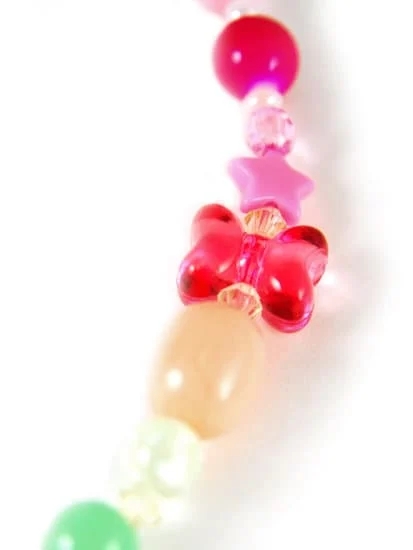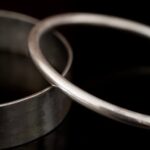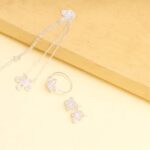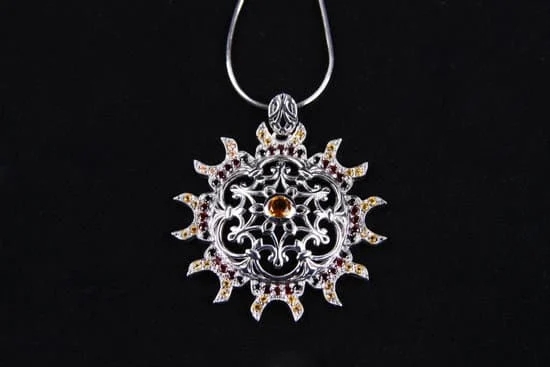In recent years, there has been a significant rise in the popularity and demand for laboratory diamond jewelry. With advancements in technology, lab-grown diamonds have become a compelling alternative to natural diamonds. Not only do they possess the same chemical composition and physical properties as their naturally occurring counterparts, but they also offer several advantages that have captivated consumers worldwide.
One question that often arises when it comes to laboratory diamond jewelry is whether repairs can be done on these pieces. As with any type of jewelry, wear and tear or accidents may occur, leading to potential damage. In this article, we will explore the possibilities of repairing laboratory diamond jewelry and provide insights into the process, costs involved, as well as tips for maintaining the longevity of these exquisite pieces.
Laboratory diamond jewelry offers a sustainable and ethical option for those seeking stunning gemstones. The lab-grown diamonds are grown in controlled environments using advanced scientific processes that mimic the geological conditions responsible for natural diamond formation. This allows for precision and control over the diamond’s characteristics and quality. Lab-grown diamonds are indistinguishable from natural ones to the naked eye and possess similar brilliance, clarity, color, and durability.
The growing demand for laboratory diamond jewelry is largely driven by its ethical aspects. Consumers are increasingly concerned about the environmental impact associated with mining natural diamonds and want assurance that their purchase has not contributed to human rights abuses or conflict financing in diamond-rich regions. Moreover, lab-grown diamonds are generally priced lower than natural counterparts, making them an affordable luxury for many individuals.
Now that we have established the rise of laboratory diamond jewelry as well as its numerous advantages over traditional mined diamonds let us delve into whether repair is possible on these captivating gemstones.
Understanding the Composition of Laboratory Diamond Jewelry
Laboratory diamond jewelry is becoming increasingly popular as people recognize the advantages of opting for lab-grown diamonds over natural ones. Understanding the composition of laboratory diamond jewelry is essential for both consumers and jewelers alike.
The science behind laboratory diamond creation involves using innovative technology to replicate the conditions that naturally occur in the Earth’s mantle, where diamonds are formed. This process produces diamonds that have the same chemical and physical characteristics as natural diamonds. The main difference between lab-grown and natural diamonds is their origin.
Despite their origins, lab-grown diamonds possess the same durability and quality as natural diamonds. They have the same hardness on the Mohs scale and exhibit similar scratch resistance. Additionally, they share other desirable properties such as brilliance and fire. This means that laboratory diamond jewelry can be just as beautiful and long-lasting as their natural counterparts.
| Comparison Aspect | Lab-Grown Diamonds | Natural Diamonds |
|---|---|---|
| Composition | Synthetic, grown in a controlled environment | Naturally occurring in the Earth’s mantle |
| Durability | Same hardness on the Mohs scale, scratch-resistant | Same hardness on the Mohs scale, scratch-resistant |
| Aesthetics | Similar brilliance and fire as natural diamonds | Similar brilliance and fire as lab-grown diamonds |
Understanding these similarities and differences between lab-created and natural diamonds provides an important foundation for discussing the repairability of laboratory diamond jewelry.
Common Repair Issues with Laboratory Diamond Jewelry
One of the main concerns individuals may have when purchasing laboratory diamond jewelry is whether these pieces can be repaired if they become damaged. Like any type of jewelry, lab-grown diamond jewelry may experience wear and tear or accidents that require repair. In this section, we will explore the common repair issues that laboratory diamond jewelry may face and address concerns about their repairability.
Laboratory diamond jewelry can encounter similar issues as natural diamond jewelry. For example, prongs holding the stones in place may become loose or break over time, resulting in a risk of losing the diamonds. Additionally, the metal settings or bands of the jewelry piece can tarnish or show signs of damage due to regular wear. Another common issue is scratches on the surface of the lab-grown diamonds or other gemstones used in the design.
Repairs may also be necessary due to accidental damage, such as dropping a piece of laboratory diamond jewelry or hitting it against a hard surface. These incidents can result in chips, cracks, or even complete breakage of the diamonds. It’s important to note that while lab-grown diamonds are durable and resistant to damages, they are not indestructible.
Despite potential damages, repairing laboratory diamond jewelry is indeed feasible. Skilled jewelers who specialize in lab-grown diamond repairs can address these common issues effectively and ensure the longevity of your precious pieces. By recognizing these common repair issues with laboratory diamond jewelry, you can be better prepared to seek professional assistance when needed, allowing you to fully enjoy your stunning creations for years to come.
- Loose or broken prongs
- Tarnished metal settings
- Surface scratches on lab-grown diamonds
- Accidental chips, cracks, or breakage
Choosing a Skilled Jeweler for Laboratory Diamond Repairs
When it comes to repairing laboratory diamond jewelry, it is crucial to find a skilled jeweler who specializes in working with these unique stones. Not all jewelers have the necessary expertise and experience to effectively repair lab-grown diamonds. To ensure the best results and the preservation of your investment, here are some important factors to consider when choosing a jeweler for laboratory diamond repairs.
First and foremost, it is essential to find a reputable jeweler who has experience specifically working with lab-grown diamonds. Look for jewelers who have certifications or qualifications in handling and repairing laboratory diamonds. These certifications demonstrate their knowledge and proficiency in dealing with this type of jewelry. Additionally, seek out recommendations from friends or family members who may have had positive experiences with jewelers specializing in lab-grown diamond repairs.
Another important consideration when selecting a jeweler is their level of expertise in repairing laboratory diamond jewelry. Ask about their track record and inquire if they have successfully repaired similar pieces in the past. It may be helpful to request before-and-after photographs or references from previous customers as further evidence of their capabilities.
Furthermore, make sure that the chosen jeweler has access to the necessary tools and equipment required for repairing laboratory diamond jewelry. Since these stones have unique properties, specialized equipment is often needed for any repairs or restoration work. Therefore, confirming that the jeweler possesses the proper tools will help guarantee that your jewelry is being handled correctly and professionally.
Ultimately, choosing a skilled jeweler for laboratory diamond repairs entails conducting thorough research and making informed decisions based on qualifications, experience, testimonials, and available resources. By doing so, you can rest assured that your precious lab-grown diamond jewelry will receive expert care and attention during the repair process.
Remember to stay tuned for our next section where we will delve into the details of the repair process involved when restoring laboratory diamond jewelry.
The Repair Process for Laboratory Diamond Jewelry
When it comes to repairing laboratory diamond jewelry, it is important to understand the intricate process involved. While lab-grown diamonds boast durability and quality, they are not indestructible. Wear and tear or accidental damage can occur, requiring repairs to restore their beauty and functionality.
Repairing laboratory diamond jewelry typically follows a series of steps that require specialized equipment and techniques. The process starts with a thorough assessment of the damage by a skilled jeweler who specializes in lab-grown diamond repairs. This initial evaluation helps determine the necessary repairs and estimate the cost.
Once the assessment is complete, the next step involves carefully disassembling or removing any parts of the jewelry that need repair. For example, if a lab-created diamond has become loose in its setting, it may need to be removed before any repairs can be made.
After disassembly, the damaged parts are delicately repaired or replaced using appropriate lab-grown diamond-specific techniques and materials. Precise attention to detail is crucial during this stage to ensure that the repair seamlessly blends with the rest of the jewelry piece.
Finally, once all necessary repairs have been made, reassembly takes place along with a final inspection for quality assurance. This ensures that all repairs have been successfully completed and that the repaired laboratory diamond jewelry meets the highest standards.
Throughout this process, jewelers specializing in lab-grown diamond repairs may face certain challenges unique to these types of stones. For example, because lab-created diamonds can have slightly different physical properties compared to their natural counterparts, jewelers must adapt their techniques accordingly.
Restoration Options for Laboratory Diamond Jewelry
Restoring laboratory diamond jewelry can be a complex process that requires the expertise of skilled jewelers familiar with lab-grown diamonds. Fortunately, there are various restoration options available for different types of damages. Whether your laboratory diamond jewelry needs to have a loose stone reset or a scratched surface repaired, a reputable jeweler specializing in lab-grown diamond repairs can offer appropriate solutions.
One common restoration option for laboratory diamond jewelry is re-polishing. Over time, lab-grown diamonds may develop scratches or surface dullness due to regular wear. A skilled jeweler can restore the diamond’s brilliance by carefully removing surface imperfections through re-polishing. This process involves using specialized equipment and techniques to remove a small layer of the diamond’s surface, revealing its original shine.
In some cases, if laboratory diamond jewelry has sustained significant damage such as chips or cracks, more extensive repair methods may be necessary. Jewelers can utilize techniques such as bezel replacement or foiling to address these issues.
Bezel replacement involves removing the damaged bezel setting around the diamond and replacing it with a new one without affecting the structural integrity of the piece. Foiling is another method used to repair chips by filling them with a special adhesive material that closely resembles the natural facets of a diamond.
It is important to note that during any restoration process, jewelers take utmost care to maintain the visual appearance and quality of lab-grown diamonds. They ensure that no additional stress or damage is inflicted on the jewelry during repairs. By choosing an experienced professional, you can have confidence in their ability to effectively restore your laboratory diamond jewelry and deliver results that meet your expectations.
Cost of Repairing Laboratory Diamond Jewelry
When it comes to repairing laboratory diamond jewelry, one important consideration is the cost. The cost of repair can vary depending on several factors.
Firstly, the extent of damage plays a significant role in determining the cost of repair. Minor damages such as loose stones or small scratches may be relatively inexpensive to fix, while more severe damages like a broken band or larger diamond replacements may require more extensive and costly repairs.
Another factor that influences the cost is the type of repair required. Different types of repairs have different levels of complexity and time requirements. For example, prong re-tipping or resizing a ring may be less expensive compared to intricate stone setting work or repairing complex structural issues.
Additionally, the expertise and reputation of the jeweler can impact the cost. Highly skilled jewelers who specialize in lab-grown diamonds might charge a higher fee for their services due to their expertise and knowledge in handling these unique stones.
It’s also essential to consider any potential additional expenses beyond the basic repair work. This could include costs for materials such as replacement diamonds or metals if needed, as well as any necessary certifications or documentation for insurance purposes.
As with any type of repair service, it’s always recommended to obtain multiple quotes from different jewelers to ensure you are getting a fair price. Additionally, don’t solely focus on finding the cheapest option; prioritize quality craftsmanship and expertise when choosing a jeweler for repairing your laboratory diamond jewelry.
Understanding the factors influencing the cost of repairs can help you make informed decisions when it comes to maintaining and restoring your lab-grown diamond jewelry. Remember that investing in high-quality repairs done by reputable professionals can ultimately save you money in the long run by preserving the value and longevity of your precious pieces.
Maintaining and Preventing Damage to Laboratory Diamond Jewelry
When it comes to laboratory diamond jewelry, proper maintenance is crucial in order to ensure its longevity and sparkle. By following a few simple tips, you can keep your lab-grown diamonds looking their best and reduce the risk of damage.
Practical Tips for Maintenance
One of the most important aspects of maintaining laboratory diamond jewelry is to handle it with care. Lab-grown diamonds may have similar physical properties to natural diamonds, but they are not indestructible. Avoid exposing your jewelry to harsh chemicals or abrasive materials that can scratch or dull the surface of the stones. When storing your lab-grown diamond jewelry, it’s best to keep it separate from other pieces to prevent any potential damage.
Regular cleaning is also essential for preserving the brilliance and shine of laboratory diamond jewelry. You can clean your pieces at home using a mild detergent mixed with warm water. Gently scrub the jewelry with a soft-bristled brush, making sure to reach all the crevices. Rinse thoroughly and pat dry with a soft cloth. It’s important to avoid using ultrasonic cleaners or steamers, as they may cause damage to certain types of lab-grown diamonds.
Preventive Measures for Minimizing Damage
While accidents happen, there are preventive measures you can take to minimize the risk of damage to your laboratory diamond jewelry. It’s advisable to remove your jewelry when engaging in activities such as household chores, sports, or vigorous exercise where it can be subjected to impact or force. The same applies when applying lotions, perfumes, or hair products which may contain chemicals that could potentially degrade the appearance of your lab-grown diamonds.
It’s also important to regularly inspect your laboratory diamond jewelry for loose stones or prongs that may be compromised. If you notice any issues, avoid wearing the piece until it has been properly repaired by a skilled jeweler experienced in lab-grown diamond repairs. Routine check-ups with a professional jeweler can help detect any potential problems early on and prevent further damage or loss of stones.
By following these maintenance and prevention tips, you can ensure the longevity and beauty of your laboratory diamond jewelry. However, in case accidents do occur, it’s comforting to know that repairs are possible for lab-grown diamonds, as discussed in the previous section. Seek out reputable jewelers who specialize in lab-grown diamond repairs and share your experiences with fellow enthusiasts to create a helpful community for all lovers of laboratory diamond jewelry.
Conclusion
In conclusion, the rise of laboratory diamond jewelry has brought about a growing demand for repair services. As discussed in this article, laboratory diamond jewelry offers numerous advantages over natural diamonds, including durability and quality. It is important to understand that just like natural diamonds, lab-grown diamonds can also experience wear and tear or accidental damage, making repairs necessary at times.
When it comes to repairing laboratory diamond jewelry, it is crucial to choose a skilled jeweler who specializes in working with lab-grown diamonds. Researching and selecting a reputable professional with certifications and experience in lab-grown diamond repairs is essential to ensure the best results.
The repair process for laboratory diamond jewelry involves using specialized equipment and techniques to restore the pieces effectively. While there may be some challenges faced by jewelers when repairing lab-created diamonds, successful restoration cases have been reported with satisfactory outcomes.
Considering the cost aspect of repairing laboratory diamond jewelry, factors such as the type of damage and the complexity of the repair will influence the overall expense. However, it is important not to skimp on repairs as they are necessary to maintain the longevity and visual appeal of your lab-grown diamond jewelry.
Frequently Asked Questions
Can lab-grown diamonds be damaged?
Lab-grown diamonds can be damaged, just like natural diamonds. However, they are not inherently more fragile or susceptible to damage. Lab-grown diamonds possess the same physical and chemical properties as natural diamonds, making them equally durable.
The hardness of a diamond, whether lab-created or mined, is determined by its crystalline structure and strong carbon bonds. Nonetheless, it’s important to note that any diamond can chip or fracture if subjected to extreme force or impact.
Can a jeweler recognize a lab created diamond?
A skilled jeweler can indeed recognize a lab-created diamond by conducting various tests and using specialized equipment. These tests may include examining the diamond under magnification to detect certain growth characteristics only present in lab-grown diamonds, such as specific types of inclusions or growth patterns.
Additionally, jewelers can use advanced instruments that measure electrical conductivity or thermal conductivity to differentiate between lab-grown and natural diamonds. With the appropriate expertise and tools, jewelers can usually identify lab-created diamonds accurately.
Are lab diamonds not worth it?
Whether lab-grown diamonds are worth it depends on individual preferences and priorities when it comes to purchasing a diamond. From a quality standpoint, lab-created diamonds offer nearly identical physical attributes to natural ones without the ethical concerns associated with mining practices. They are environmentally friendly and do not contribute to human rights issues connected with traditional diamond mining regions.
Moreover, lab-created diamonds often come at a lower price point than their mined counterparts for similar specifications. However, some people still hold sentimental value towards naturally occurring diamonds due to their rarity and historical significance in the jewelry industry. Ultimately, whether a lab-grown diamond is worth it is subjective and depends on one’s personal values and preferences when choosing a diamond.

Welcome to my jewelry blog! My name is Sarah and I am the owner of this blog.
I love making jewelry and sharing my creations with others.
So whether you’re someone who loves wearing jewelry yourself or simply enjoys learning about it, be sure to check out my blog for insightful posts on everything related to this exciting topic!





